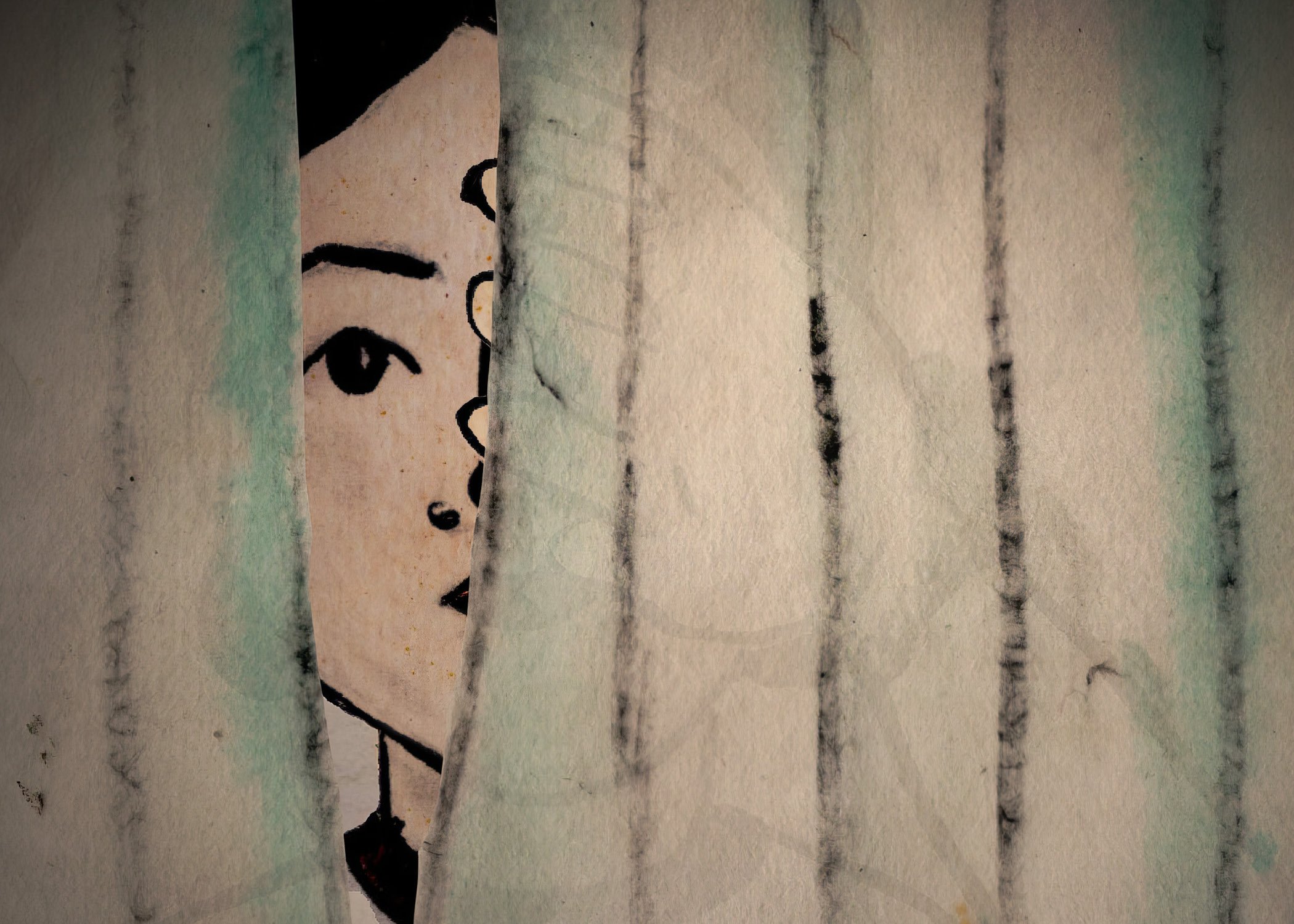ANCESTRAL DREAMS & OTHER PREMONITIONS
Cindy Mochizuki
Central Gallery
April 20 to July 6, 2024
Curated by Charo Neville
In this first survey presentation of Cindy Mochizuki’s practice, the through lines of enduring and intersecting themes emerge through four key artworks. As a significant part of her artistic process, Mochizuki’s projects work through material and story recovery where she engages family members, community participants, and archives to realize and shape her multi-media installations. Mochizuki brings forth unofficially documented immigrant stories as a way of exploring relationships to the transpacific, invisible histories, archives, and memory. As a Japanese Canadian artist based in Vancouver, BC, Mochizuki’s work is informed by and within Japanese Canadian communities in British Columbia and Japan. She works closely with members of these communities and often includes her paternal family’s history, both within internment camps in Canada during World War II and through their experiences as repatriated Japanese Canadians (kika-nisei) in post-war Japan.
Employing audio fiction, performance, animation, and community engagement, Mochizuki’s work delves into the manifestation of story and its complex relationships to specific sites. Drawing on extensive research and memory work, her approach moves fluidly between multiple sites of cultural production and considers language, performativity, chance, and improvisation. Through her commitment to relationship-building, Mochizuki has opened pathways for Japanese Canadians to share stories shaped by trauma that are more commonly kept private through silence. It is these stories that shape and inform Mochizuki's practice.
Ancestral Dreams & Other Premonitions is an immersive experience that communicates real and imaginary realms. The multi-faceted projects Autumn Strawberry, 2021, and Tides & Moons: Herring Capital, 2022, focus on histories of food production in relation to marginalized Japanese labour in BC within the context of the Canadian government’s systematic racist policies and interment process during and after World War II (WWII). Autumn Strawberry shares stories of Nisei elders (second generation Japanese Canadians born and raised in BC) and their Issei parents, who had hopeful dreams of a new life in Canada. Set in both the past and future in an area once called Strawberry Hill or Chicken Mura, this installation re-imagines the experience of Japanese settler families prior to their internment during WWII, who made homes and livelihoods on the berry farms across the Fraser Valley in BC. Coming alive through a theatrical setting, Autumn Strawberry animates the stories of these Nisei elders who were children during the time their parents and grandparents had owned and worked on these farms. Stories of everyday life merge with a ghostly future world of trees and insects to convey an ominous sense of the complexities of these histories.
Tides & Moons: Herring Capital is a dynamic animated installation that brings to life the history of Nanaimo, BC, when it was known as the “herring capital,” a food industry run by Japanese Canadian fishing and boat-building families who populated the shorelines of Nanaimo before World War II. In this work, Mochizuki uses animation, miniature sets, and activated storytelling props to re-imagine the complex relationships between salt, intertidal zones, and marginalized labour. Tides & Moons reveals the irony of the Province’s economic dependence on Japanese workers in developing Nanaimo as a herring capital in the 1920s, and the subsequent dispossession of Japanese fishers and their families only 20 years later when Japanese people were relocated to camps in the BC interior and sugar beet farms in Alberta.
Representing otherworldly aspects of Mochizuki’s practice, The Sakaki Tree, a Jewel, and the Mirror, 2020, explores Japanese legends and folklore through 50 figurines that bear heads, feet, and hair, and together with their shadows make 100 enigmatic entities. In this installation and its activation through intimate performances that use the figures as tools for divination, Mochizuki tells the story of Amaterasu, the Shinto goddess of the sun and the universe. Like lucky talismans, or archetypes, they recall the puppets of traditional Japanese Bunraku theatre.
Similarly, in her 2019 work Cave to Dream, Mochizuki considers the passage of time, life and death, and the power of dreams. Developed through an artistic residence at the Akita University of Art in Akita, Japan, in 2017, Cave to Dream is a multi-media installation with sound, hand drawn animation, and live-action video. Cave to Dream unfolds as four fictional videos—Onyx, Salt, Shadow and Snow—embedded within cave-like armatures. Building on metaphors of the cave, narratives are told by human and non-human characters that move through various dreamscapes, environments, and psychic spaces. This earlier work embodies the way in which Mochizuki transforms the gallery space so it can hold many forms and social encounters, thinking across multiple timelines and experiences and amplifying stories of ghosts and demons carried by Asian and immigrant diasporas.
Weaving together multi-generational experiences, this exhibition connects the present, past, and future to give voice to personal stories that reveal a larger narrative of Japanese resilience in Canada. Mochizuki’s ambitious multi-media environments hold space for difficult histories to be understood by immersing us in re-imagined worlds, not unlike a dream.
Artist Biography
Cindy Mochizuki has exhibited, performed, and screened her work in Canada, the United States, Australia, and Japan. Recent exhibitions include the Nanaimo Art Gallery, Surrey Art Gallery, Vancouver Art Gallery, Burrard Arts Foundation, and Richmond Art Gallery in BC; Prince Takamado Gallery, Embassy of Canada to Japan, Tokyo; Frye Art Museum, Seattle, Washington; and Yonago City Museum, Japan. She has performed solo multi-media performances as part of 7a*11d, International Festival of Performance Art, in Toronto, Ontario, and Richmond World Festival with Cinevolution Media Arts Society in Richmond, BC. Mochizuki is the recipient of the Vancouver Mayor’s Arts Award in New Media and Film, 2015, and the Jack and Doris Shadbolt Foundation for the Visual Arts VIVA Award, 2020. She has worked as a scenographer, dramaturge, and created animation design for theatre and dance companies, including Theatre Replacement, Dreamwalker Dance Company, Little Onion Puppet Co, Lisa Mariko Gelley, Rumble Theatre, The Arts Club, and Theatre Calgary. Her community-engaged projects include Hato Bue Choir, Tonari Gumi; Magic School, Daisen Laboratory, Japan; Things on the Shoreline, Access Artist Run Centre, Vancouver; and Shako Club, grunt gallery, Vancouver. Mochizuki received her Master of Fine Arts degree in Interdisciplinary Studies through the School for Contemporary Arts at Simon Fraser University, Burnaby, BC, in 2006.
This exhibition is generously supported by the Women’s Art Initiative.
A D D I T I O N A L R E S O U R C E S
Cindy Mochizuki
Autumn Strawberry, 2021
multi-media installation; watercolour on paper and digital animation
60 minutes
Installation view, Kamloops Art Gallery
Photo: Teresa Donck-Matlock

















